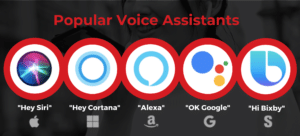Voice search is a type of voice recognition technology that enables users to conduct searches with natural language instead of typing. It works by recognising and interpreting human speech, converting it into text, and finding the most relevant results based on the user’s query.
This form of search has become increasingly popular in recent years due to its convenience, however, it may not be the ideal choice for performance digital marketing. In this post, we’ll explore the advantages of voice search and its impact on SEO, how you can optimise your content for voice search, and what the challenges around voice search for performance marketing are.
The Advantages of Voice Search
Convenience for users
Voice search allows users to perform internet searches by speaking into their device, rather than typing keywords into a search bar. This can be more convenient for users as it allows them to search for information hands-free, for example, while cooking or driving.
Voice search can also save time for users by providing more accurate search results, as it can recognise natural language and context, making it easier for users to find the information they need.
Increased accuracy of results
Voice search can provide more accurate results than traditional text-based search because it can recognise natural language and context. This allows it to understand the intent behind a user’s search query, rather than just matching keywords.
Voice search also allows users to perform longer, more specific, and more complex queries, which can lead to more relevant results. This can lead to a better user experience as users are more likely to find what they are looking for, which in turn can increase engagement with a brand.
Optimising a website for voice search can also help to improve the visibility of a brand and increase the chances of users discovering the products and services offered by a business.
Advancement of SEO
In terms of SEO, the growing popularity of voice search makes it more important to optimise content to match natural language queries. This means focussing on creating content that is more conversational and that uses the same language that users would use when speaking.
Voice search requires a different approach to keywords. Rather than using traditional keywords, businesses will need to focus on using conversational keywords that match the way people talk and ask questions naturally.
To take advantage of voice search, it’s important to focus on conversational keywords, semantic search, and structured data:
- Conversational keywords are phrases or questions that users may use when asking a voice-controlled device. By including these keywords in your website’s content, it can increase the chances of your website appearing in voice search results.
- Semantic search is the process of understanding the intent behind a user’s query, and it can help to match the user’s query with the most relevant content.
- Using structured data such as schema markup can help search engines to better understand the content on a website and to match it with users’ queries. This can help to increase the visibility of a website in voice search results.
Integration with other technologies
Voice search can be integrated with other technologies, such as virtual assistants and smart home devices. Virtual assistants, such as Amazon’s Alexa, Google Assistant, and Apple’s Siri, are software programs that can be controlled by voice commands. These virtual assistants can be integrated with smart home devices, such as thermostats, lighting, and security systems, allowing users to control these devices by voice commands.

The integration of voice search with virtual assistants and smart home devices can provide additional opportunities for businesses to engage with their customers. For example, businesses can develop skills or actions for virtual assistants that allow customers to interact with their brand in new ways.
For instance, a retail business could develop an action for a virtual assistant that allows customers to check product availability, place an order, or track delivery status. Or a food delivery service can develop a skill that enables customers to order food through their virtual assistant.
Integration of voice search with other technologies such as virtual assistants and smart home devices can open up new opportunities for businesses to engage with their customers, by providing new ways to interact with their brand and make their services more accessible and convenient.
Challenges of Voice Search for Performance Marketing
While voice search creates a lot of new opportunities for brands, it also creates a few challenges for digital marketers!
Lack of Targeted Ads
Targeted ads are more effective in driving conversions because they are tailored to a specific audience based on demographics, interests, or behaviour. This means that the ads are more likely to be relevant to the user, which increases the chances that they will click on the ad and convert.
For example, if a business sells hiking gear, it could target ads to users who have shown an interest in hiking or outdoor activities. This would increase the chances that the user would be interested in the products and be more likely to convert.

With voice search, it can be difficult to target specific demographics or interests because the search queries are typically more conversational and less specific than typed searches. As a result, it’s harder for businesses to know exactly what a user is looking for and to present them with relevant ads.
Inaccuracy in Search Results
Another challenge of voice search for performance marketing is inaccuracy. Speech recognition technology is still developing, and it can sometimes be difficult for the search engine to accurately interpret spoken queries.
This can lead to errors or misunderstandings in the search results, which can make it harder for businesses to reach their target audience. For example, if a user is looking for a specific product, but the search engine misunderstands their query and returns irrelevant results, the user may become frustrated and leave the website without making a purchase.
This not only leads to a poor user experience, but also can impact the conversion rate and therefore business revenue. This said, as the technology continues to improve and speech recognition technology becomes more sophisticated, it’s likely that these inaccuracies will become less of an issue.
Limited Data for Optimisation
Another challenge of voice search for performance marketing is the limited data available for optimisation and analysis. Voice search queries are often private and less trackable, which means that there is less data available to understand how users interact with a website or a brand. This can make it harder for businesses to optimise their marketing efforts and improve their performance.
The limitation of data also makes it harder to track conversion rates, which is crucial in performance marketing. (Conversion rate is a metric that measures how many website visitors take a desired action, such as making a purchase or filling out a form.) Without accurate data on conversion rates, it can be difficult for businesses to identify areas of their website or marketing strategy that need improvement, and harder to track the customer journey.
Search Results are Limited
Voice search (because it’s primarily used on mobile devices or smart speakers) mostly returns local search results. This is because the search engine tries to match the user’s location with the query, to provide the most relevant local options.
This may not be suitable for businesses that are looking to target a global audience. For example, a business that sells products online and ships worldwide may not appear in local search results, and this can make it harder for them to reach their target audience.
On the flipside, for businesses that have a physical location, the focus on local search results can make it harder for them to reach customers outside of their immediate area, which can limit their growth potential.
How to Optimise for Voice Search

Understanding voice search queries
The differences between text-based search queries and voice search queries are in their nature and format. Text-based search queries are typically short and specific, while voice search queries are often longer and more conversational. Text-based searches typically use keywords, while voice searches are more likely to use natural language and complete sentences.
Understanding natural language and conversational keywords are crucial when optimising for voice search because it allows businesses to anticipate the types of queries that users are likely to use when searching by voice. This can help businesses to create content that is more likely to appear in voice search results, and to make sure that their website is optimised for the types of queries that users are likely to use.
For example, if a business sells hiking gear, they should optimise their website for keywords like “best hiking boots for beginners” or “hiking gear for a day trip”, instead of just “hiking boots” or “hiking gear” which are text-based keywords.
Optimising content for voice search
To optimise your website’s content for voice search, it’s important to use natural language and long-tail keywords. This means that you should focus on creating content that is written in a conversational tone and that uses the same language that users would use when speaking.
Here are some examples of how to use natural language and long-tail keywords in your content:
- Instead of using “best hiking boots”, use “What are the best hiking boots for beginners?”
- Instead of using “coffee shop”, use “Where is the nearest coffee shop with outdoor seating?”
- Instead of using “smartphone deals”, use “What are the best smartphone deals for students?”
Long-tail keywords are more specific and will attract more qualified leads and customers who are looking for specific products or services.
Finally, it’s also important to create content that is easy to read and understand for both users and search engines. This means that you should use a clear and simple language, use headings and subheadings to break up the text and make it easier to skim, and use images and videos to make your content more engaging and informative.
Optimising for local search
Voice search queries are often location-based, so search engines try to match the user’s location with the query to provide the most relevant results. This means that if your business is not optimised for local search, it may not appear in the search results when users are looking for businesses in your area.
Having accurate and up-to-date business information on your website and on local listing sites is crucial when it comes to local search optimisation. This information should include your business name, address, phone number, hours of operation, and any other relevant details.
Having accurate and consistent information across different platforms can help to improve your visibility in local search results, and make it more likely that users will be able to find your business when they are looking for businesses in your area.
Here are some tips on how to use Google My Business to optimise for local voice search:
- Make sure your business information is accurate and up-to-date.
- Use keywords in your business name and in your business information.
- Add photos and videos to your Google My Business listing.
- Encourage your customers to leave reviews on your Google My Business listing. (And be sure to respond to them!)
Optimising for featured snippets
Featured snippets are short, summary answers to a user’s query that appear at the top of the search results page. These snippets are designed to provide users with quick and easy access to the information they are looking for.

Featured snippets are particularly important for voice search because they are often used as the source of information for voice assistants like Alexa, Google Assistant and Siri. Optimising your content to be selected as a featured snippet can improve your visibility in voice search results.
Here are some tips on how to optimise for featured snippets:
- Use question-based keywords in your content, as featured snippets often come from content that answers a question.
- Use short, simple, and direct language.
- Use headings and subheadings to break up the text and make it easy to scan.
- Use bullet points and lists to organise information.
Optimising for Voice assistants
Voice assistants and smart speakers are important mediums for voice search because they allow users to interact with their devices and search for information hands-free. As the use of these devices continues to grow, it’s important for businesses to optimise their content and services to reach this audience.
To optimise for skills and actions for smart speaker platforms like Alexa and Google Actions, businesses can do the following:
- Develop a skill or action that allows users to interact with their brand in a new way. For example, a retail business could develop an action that allows users to check product availability, place an order, or track delivery status.
- Use natural language and conversational keywords in the skill or action to make it easy for users to interact with.
- Use analytics and customer feedback to improve and optimise the skill or action.
- Try to add value and make it useful and relevant to the users – not just a feature that is there for the sake of it.
In conclusion
Voice search can provide convenience for users, and increased practicality thanks to the inclusion of conversational keywords and semantic search results. The integration of voice search with other technologies, such as virtual assistants and smart home devices, can provide additional opportunities for businesses to engage with their customers. But there are also challenges – such as a lack of targeted ads, inaccuracies in search results, limited or private data, and geographically restricted search results.
While voice search is becoming more popular, it may not be the best option for performance digital marketing, and businesses should consider other strategies to optimise their online presence. As voice search is still a relatively new technology, it’s important for businesses to stay informed and adapt their marketing strategies as the technology evolves. Businesses should also consider other digital marketing strategies, such as SEO, PPC, social media marketing, and email marketing, to reach their target audience and achieve their performance goals.



